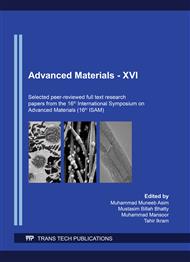[1]
Y. Lin, H. Chen, G. Wang, and A. Liu, Recent Progress in Preparation and Anti-Icing Applications of Superhydrophobic Coatings, Coatings. 8(6) (2018) 208.
DOI: 10.3390/coatings8060208
Google Scholar
[2]
X. Zhang, F. Shi, J. Niu, Y. Jiang, and Z. Wang, Superhydrophobic surfaces: from structural control to functional application, J. Mater. Chem. 18(6) (2008) 621–633.
DOI: 10.1039/b711226b
Google Scholar
[3]
A. Steele, B. K. Nayak, A. Davis, M. C. Gupta, and E. Loth, Linear abrasion of a titanium superhydrophobic surface prepared by ultrafast laser microtexturing, J. Micromech. Microeng. 23 (2013) 115012.
DOI: 10.1088/0960-1317/23/11/115012
Google Scholar
[4]
P. Nguyen, Recent progress in the preparation, properties and applications of superhydrophobic nano-based coatings and surfaces - a review, Prog. Org. Coat. 132 (2019) 235–256.
Google Scholar
[5]
I. Etsion, State of the Art in Laser Surface Texturing, J. Tribol. 127 (2005) 248–253.
Google Scholar
[6]
B. Qiao, Y. Liang, T.J. Wang, and Y. Jiang, Surface modification to produce hydrophobic nano-silica particles using sodium dodecyl sulfate as a modifier, Appl. Surf. Sci. 364 (2016) 103–109.
DOI: 10.1016/j.apsusc.2015.12.116
Google Scholar
[7]
F.K. Skinner, Y. Rotenberg, and A.W. Neumann, Contact angle measurements from the contact diameter of sessile drops by means of a modified axisymmetric drop shape analysis, J. Colloid. Interface. Sci. 130 (1989) 25–34.
DOI: 10.1016/0021-9797(89)90074-x
Google Scholar
[8]
J.E. Martínez, Wettability modification of the AISI 304 and 316 stainless steel and glass surfaces by titanium oxide and titanium nitride coating, Surf. Coat. Technol. 330 (2017) 61–70.
DOI: 10.1016/j.surfcoat.2017.09.059
Google Scholar
[9]
J. Li, D. Xiong, J. Dai, Z. Huang, and R. Tyagi, Effect of surface laser texture on friction properties of nickel-based composite, Tribol. Int. 43 (2010) 1193–1199.
DOI: 10.1016/j.triboint.2009.12.044
Google Scholar
[10]
A. Wilson, A. Matthews, J. Housden, R. Turner, and B. Garside, A comparison of the wear and fatigue properties of plasma-assisted physical vapour deposition TiN, CrN and duplex coatings on Ti-6Al-4V, Surf. Coat. Technol. 62 (1993) 600–607.
DOI: 10.1016/0257-8972(93)90306-9
Google Scholar
[11]
B.N. Arzamasov, S. G. Babich, L.G. Kirichenko, V.M. Knyazheva, V.I. Silaeva, and T.V. Solov'eva, Properties of aluminum alloys with a titanium nitride coating, Met. Sci. Heat Treat. 36 (1994) 308–312.
DOI: 10.1007/bf01401073
Google Scholar
[12]
M.S. Trtica, B.M. Gaković, and B.B. Radak, Surface modifications of TiN coatings by a pulsed TEA CO2 laser: Coating thickness effects, Russ. J. Phys. Chem. A. 81 (2007) 1429–1432.
DOI: 10.1134/s0036024407090154
Google Scholar
[13]
D. Garcia-Alonso, N. Serres, C. Demian, S. Costil, C. Langlade, and C. Coddet, Pre-/During-/post-laser processes to enhance the adhesion and mechanical properties of thermal-sprayed coatings with a reduced environmental impact, J. Therm. Spray Technol. 20 4(2011) 719–735.
DOI: 10.1007/s11666-011-9629-x
Google Scholar
[14]
A.H. Hamad, Effects of different laser pulse regimes (nanosecond, picosecond and femtosecond) on the ablation of materials for production of nanoparticles in liquid solution, High Energy Short Pulse Lasers. (2016).
DOI: 10.5772/63892
Google Scholar
[15]
H. Wang, H. Shi, y. wang, The wetting of leaf surfaces and its ecological significances, in wetting and wettability, M. Aliofkhazraei, Ed. InTech. (2015).
DOI: 10.5772/61205
Google Scholar
[16]
L.B. Boinovich, A.M. Emelyanenko, A.D. Modestov, Synergistic effect of superhydrophobicity and oxidized layers on corrosion resistance of aluminum alloy surface textured by nanosecond laser treatment, ACS Appl. Mater. Interfaces, vol. 7, no. 34 (2015) 19500–19508.
DOI: 10.1021/acsami.5b06217
Google Scholar
[17]
K. Song, J. Lee, S.O. Choi, J. Kim, Interaction of surface energy components between solid and liquid on wettability, and its application to textile anti-wetting finish, Polymers, 11 (2019) 498.
DOI: 10.3390/polym11030498
Google Scholar


